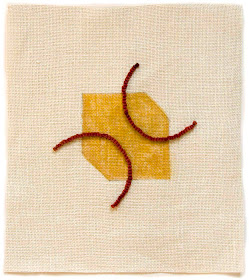 Yellow Blue Center Fall, summer 1974, oil on canvas, 15 x 15"
Yellow Blue Center Fall, summer 1974, oil on canvas, 15 x 15"
I love Elizabeth Murray's early work, so was very happy to be able to see a great show at Pace Gallery "Elizabeth Murray: Painting in the 70s". From the beginning we can see that Murray had a love affair with paint, pushing it about with the brush, building juicy textures, globs and glops, solid presences of shape and line. With this paint that refused to stay politely on the surface, Murray took the pervasive geometric abstraction of that era and turned it inside out, from mind to heart, from intellect to emotion. Small brilliant squares within an off-kilter circle express the heart of things, the hidden treasure.
 Heart Beat #2, 1973, oil on canvas, 12 x 16"
Heart Beat #2, 1973, oil on canvas, 12 x 16"
A rhythm emerges from wavering black lines radiating from a center.
 Pink and Blue Steps, 1974, oil on canvas, 36 x 44"
Pink and Blue Steps, 1974, oil on canvas, 36 x 44"
In these two paintings of steps, Murray takes forms that seem so straightforwardly geometric and infuses them with stories and off beat humor. In Up Step, those very delicate outlines floating on the green paint make rectangles that become a staircase, and an invitation to climb, to dream? And what wild colors in Pink and Blue Steps! a thumbing of the nose at seriousness, an exuberant march up and out.
 Two or Three Things, 1974, oil on canvas, 68 x 66"
Two or Three Things, 1974, oil on canvas, 68 x 66"
There are more than two or three things in this painting, 5 tiny shapes expressively placed withine the large green and yellow triangles. They convincingly shout "here we are" and we are compelled to pay attention to their color and their placement, dancing within the whole.
 Falling, 1976, oil on canvas, 9' 10'' x 9'11''.
Falling, 1976, oil on canvas, 9' 10'' x 9'11''.
A thick red line curves and curlicues and ends just shy of the tilted point of the canvas, where it is punctuated by a tiny blue square. All the life energy of the painting, embodied in that line, is humorously held up by it, in my eyes prevented from falling. With this large painting, Murray begins to play with moving away from the traditional rectangle, to great effect.
With these two paintings, Murray has begun to shape her canvases, to have the wall push into the painting and the shapes push in odd ways against it. Twist of Fate, with another red as life shape zigging up the canvas, has buoyant blobby forms on a jolly lime green ground mostly held in by the edges. The blue shape, by some happenstance, is cut off. The green shape of the Druid exists within its allotted space, but pushes against it, encircled by a blue bar. These paintings are so alive that they pulse and seem to jump off the wall. Elizabeth Murray is a storyteller in paint, who imbues each shape with feeling, and with implied meaning that we are free to tease out as we will.
















































